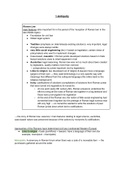Summary
Extensive Global Legal History Summary (weeks 1-12) - recommended for final Exam
- Course
- Institution
The document contains the content of all lecture weeks and is not only summarized but explicitly explained. The document includes the main topics throughout the course with notes from the PowerPoint presentations, lectures, interactive sessions and readings. Hence, the document covers all topics re...
[Show more]



